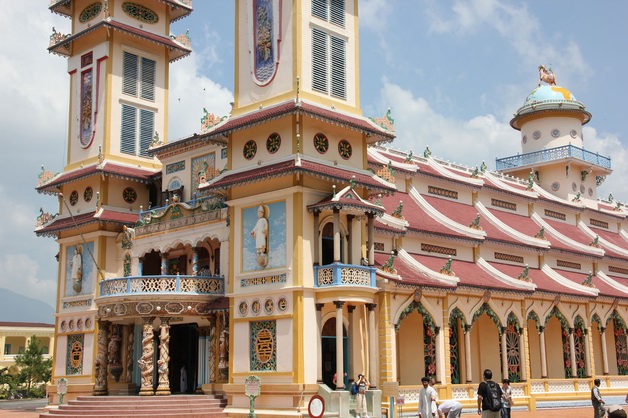Cao Dai Holy See

Caodaism is a new Vietnamese faith. It originated from Ngo Van Chieu, a
minor civil servant on
Phu Quoc Island, in the early 1920s. During a séance,
he was contacted by a spirit called the Cao Dai (high position) who handed
down a creed and symbol – the ‘all-seeing eye’.
The ‘religion’ began to take off after a second series of revelations by the
Cao Dai. He told Ngo Van Chieu that he had already manifested itself to
humanity using Confucius, Christ, Mohammed, and other vehicles to propagate
belief structures appropriate to the varying world cultures, but was
disenchanted by the intolerance and hatred between followers of the
different creeds.
It proposed to dispense with living envoys and reveal a unified and
universal religion – the ‘Third Alliance’ - through ‘saints’, spirit
intermediaries such as Joan of Arc, Winston Churchill, Victor Hugo and
Napoleon Bonaparte.
Despite the proposed universality of the Cao Dai’s doctrine, the religion
was mainly an amalgam of Buddhism, Confucianism and Taoism, with a few
aspects of Christianity and Islam. The creed worships a universal god
symbolised by the all-seeing eye, and lays down five commandments. The soul
of those who comply will be elevated to a higher plane of existence through
reincarnation. The organisation of the new faith borrowed heavily from the
Catholic Church's hierarchical structure.
Caodaism was recognised by the French in 1926, selected its first ‘Pope’,
and established a ‘Holy See’ in
Tay Ninh province. This was a large,
flamboyant temple surrounded by a school, a hospital and other support
buildings.
By 1930, Caodaism had garnered well over half a million converts and was
becoming a powerful force in the land. It adopted a more politically
oriented outlook, and set up a private army. Although the Cao Dai ‘army’
initially fought alongside the Viet Minh against the French, but turned
against their erstwhile allies after the colonialists were expelled.
The upshot was that the structure of Cao Dai, already weakened by conflict,
was dismantled by the communists after the liberation of the South. Its
leaders were imprisoned or exiled, ant its lands and property confiscated.
A decade later, most Cao Dai property was returned, and the religion resumed
its steady growth, albeit under tight state control.
The
Cao Dai Holy See is well worth a visit. The temple, dominated by the
all-seeing eye, is an architectural wonder, a hotchpotch of styles from its
contributing religions and ornamented in brilliant colours.
The daily service is impressive. The worshippers wear robes of different
hues denoting their function and status, and kneel in blocks in the nave to
genuflect and pray while acolytes perform complex rituals.
Visitors are welcomed to the service, but must remove their shoes at the
door. There are separate entries men and women. Photography is permitted,
but it’s polite not to subject the worshippers to a barrage of flashlights.
After the service, visitors can wander around the nave, but are requested
not to go beyond the pink candy-stripe pillars.
The Holy See is near Tay Ninh town, about a hundred kilometres from
Ho Chi
Minh City. The journey takes two to three hours.





